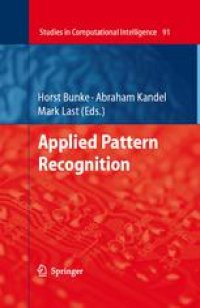
Ebook: Applied Pattern Recognition
- Tags: Appl.Mathematics/Computational Methods of Engineering, Pattern Recognition, Artificial Intelligence (incl. Robotics), Computer Imaging Vision Pattern Recognition and Graphics, Applications of Mathematics
- Series: Studies in Computational Intelligence 91
- Year: 2008
- Publisher: Springer-Verlag Berlin Heidelberg
- Edition: 1
- Language: English
- pdf
A sharp increase in the computing power of modern computers, accompanied by a decrease in the data storage costs, has triggered the development of extremely powerful algorithms that can analyze complex patterns in large amounts of data within a very short period of time. Consequently, it has become possible to apply pattern recognition techniques to new tasks characterized by tight real-time requirements (e.g., person identification) and/or high complexity of raw data (e.g., clustering trajectories of mobile objects). The main goal of this book is to cover some of the latest application domains of pattern recognition while presenting novel techniques that have been developed or customized in those domains.
A sharp increase in the computing power of modern computers, accompanied by a decrease in the data storage costs, has triggered the development of extremely powerful algorithms that can analyze complex patterns in large amounts of data within a very short period of time. Consequently, it has become possible to apply pattern recognition techniques to new tasks characterized by tight real-time requirements (e.g., person identification) and/or high complexity of raw data (e.g., clustering trajectories of mobile objects). The main goal of this book is to cover some of the latest application domains of pattern recognition while presenting novel techniques that have been developed or customized in those domains.
A sharp increase in the computing power of modern computers, accompanied by a decrease in the data storage costs, has triggered the development of extremely powerful algorithms that can analyze complex patterns in large amounts of data within a very short period of time. Consequently, it has become possible to apply pattern recognition techniques to new tasks characterized by tight real-time requirements (e.g., person identification) and/or high complexity of raw data (e.g., clustering trajectories of mobile objects). The main goal of this book is to cover some of the latest application domains of pattern recognition while presenting novel techniques that have been developed or customized in those domains.
Content:
Front Matter....Pages i-xi
Skin-based Face Detection-Extraction and Recognition of Facial Expressions....Pages 3-27
Facial Image Processing....Pages 29-48
Face Recognition and Pose Estimation with Parametric Linear Subspaces....Pages 49-74
4D Segmentation of Cardiac Data Using Active Surfaces with Spatiotemporal Shape Priors....Pages 77-100
Measuring Similarity Between Trajectories of Mobile Objects....Pages 101-128
Matching of Hypergraphs — Algorithms, Applications, and Experiments....Pages 131-154
Feature-Driven Emergence of Model Graphs for Object Recognition and Categorization....Pages 155-199
A Wavelet-based Statistical Method for Chinese Writer Identification....Pages 203-220
Texture Analysis by Accurate Identification of a Generic Markov–Gibbs Model....Pages 221-245
A sharp increase in the computing power of modern computers, accompanied by a decrease in the data storage costs, has triggered the development of extremely powerful algorithms that can analyze complex patterns in large amounts of data within a very short period of time. Consequently, it has become possible to apply pattern recognition techniques to new tasks characterized by tight real-time requirements (e.g., person identification) and/or high complexity of raw data (e.g., clustering trajectories of mobile objects). The main goal of this book is to cover some of the latest application domains of pattern recognition while presenting novel techniques that have been developed or customized in those domains.
Content:
Front Matter....Pages i-xi
Skin-based Face Detection-Extraction and Recognition of Facial Expressions....Pages 3-27
Facial Image Processing....Pages 29-48
Face Recognition and Pose Estimation with Parametric Linear Subspaces....Pages 49-74
4D Segmentation of Cardiac Data Using Active Surfaces with Spatiotemporal Shape Priors....Pages 77-100
Measuring Similarity Between Trajectories of Mobile Objects....Pages 101-128
Matching of Hypergraphs — Algorithms, Applications, and Experiments....Pages 131-154
Feature-Driven Emergence of Model Graphs for Object Recognition and Categorization....Pages 155-199
A Wavelet-based Statistical Method for Chinese Writer Identification....Pages 203-220
Texture Analysis by Accurate Identification of a Generic Markov–Gibbs Model....Pages 221-245
....